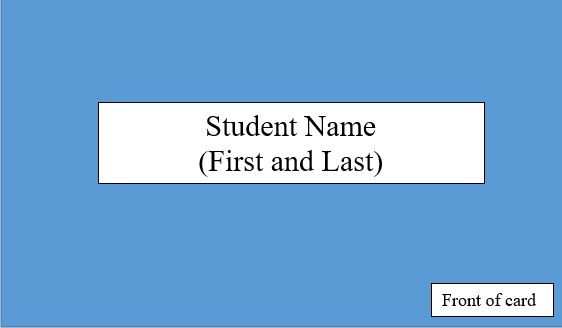Student Contributor: S. Dixon
 Cold call cards are used during class to involve a variety of students in whole class discussions. The cards are also used when there is free time after a lesson when there is not enough time left in class to start a new activity.
Cold call cards are used during class to involve a variety of students in whole class discussions. The cards are also used when there is free time after a lesson when there is not enough time left in class to start a new activity.
Cold call cards are made from index cards, and if used in a multi-class setting are color coded, with each period having a different colored card. The front of each card has each student’s first and last name. On the other side of the card students write their answers to three different ice breaker questions. Some example questions include “favorite color, favorite sport/activity, favorite artist, etc.” It is beneficial to include students in the question making process. The name portion of the card is used for cold call questions in class. The three questions can be used to build community in the classroom. My mentor teacher uses the questions to help students learn about each other. For example, if the questions are related to students’ favorite color, food, and activity he says, “Stand up if your favorite color is blue” and students who like blue stand up. He then chooses one student card and reads the other two answers to the questions without naming the student. Then he calls on students that are still standing and they must identify which classmate matches the answers to the questions. I have found this helps students learn more about their peers in a fun way.
 I placed the cold call cards in the supportive phase because they are used during class. Students have the opportunity to learn about their peers in a fun and engaging way while they are learning the required class content. This tool could potentially be placed in the preventative phase because students are building a strong classroom community based on fun facts they learn about each other. I do not believe this tool would fit in the corrective phase because the cards are meant to be used as an ice breaker rather than a method for correcting behavior. In the end, this tool fits best in the supportive phase because it helps students build a positive and comfortable classroom community. This tool is both collaborative and teacher directed. Students have the freedom to answer the questions in any way they choose but the teacher is the facilitator when the cards are used in class. The teacher uses the cards to aid students in answering class questions and to build community.
I placed the cold call cards in the supportive phase because they are used during class. Students have the opportunity to learn about their peers in a fun and engaging way while they are learning the required class content. This tool could potentially be placed in the preventative phase because students are building a strong classroom community based on fun facts they learn about each other. I do not believe this tool would fit in the corrective phase because the cards are meant to be used as an ice breaker rather than a method for correcting behavior. In the end, this tool fits best in the supportive phase because it helps students build a positive and comfortable classroom community. This tool is both collaborative and teacher directed. Students have the freedom to answer the questions in any way they choose but the teacher is the facilitator when the cards are used in class. The teacher uses the cards to aid students in answering class questions and to build community.
More Information –
Tool Source: This idea came from my mentor teacher in my 7th grade math and social studies placement.
Cold Call


